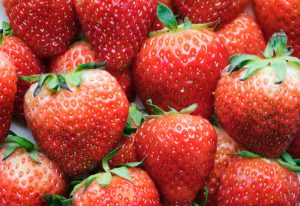
Through sequencing the genome of the garden strawberry, a biologist at The University of Alabama helped map the evolutionary history of the popular treat and provide a blueprint for future molecular breeding efforts.
“We now have a better sense of the complex history of cultivated strawberry,” said Dr. Michael McKain, assistant professor of biological sciences and curator of the UA Herbarium. “These type of genomes provide a number of challenges to genome assembly and analyses, and strawberry had potential to be exceptionally convoluted.”
McKain is a co-author on a paper, “Origin and evolution of the octoploid strawberry genome,” published in Nature Genetics outlining the work, which included a team of researchers from across the country.
The strawberry eaten across the world today is less than 300 years old, bred in France in the middle of the 18th century as a cross between species from North and South America. Its genetic make-up is complex, and this is the first time researchers have undertaken a project to completely map it.
Unlike humans, who receive one copy of their genome from each parent, a garden strawberry has eight copies of its genome, four from each parent, making it an octoploid. Humans are diploid. Both of the parent species of garden strawberry are also octoploid.
Not all wild strawberry species are octoploid as many are diploid. Some are polyploid, meaning they have more than two copies of its genome. Diploid strawberry species were of special interest to the researchers as higher ploidy species are hypothesized to be comprised of these diploid genomes or their extinct relatives.
The researchers traced the history of all four cultivated strawberry genome copies to determine ancestral origins, placing two copies from Asia and another each from Europe and North America.
Knowing the evolutionary history of the strawberry allowed the scientists to understand which copies of the genome contribute to desirable fruit quality and disease resistance traits. This information could enable molecular breeding in strawberries, providing breeders with the context for genes of interest, McKain said.
“This is the blueprint, and now someone else will come up with a strategy to use it,” McKain said.
The strawberry eaten now was created to be tastier and larger than the wild strawberries in the Americas, and it has been modified over decades to make it more appealing to consumers by improving taste, changing its color, extending shelf life or warding off disease.
Breeding takes time and money, though, and having a map of each gene copy’s role, use and contribution to desirable traits can be used to more quickly improve strawberry.
“If you know something about the genome, you can cut out a lot of trial and error,” McKain said.
Since many flowering plants and crops, like the cultivated strawberry, are polyploid, sequencing the octoploid strawberry provides a method for understanding plants that have a major impact on food security, McKain said.
Researchers at Michigan State University and the University of California, Davis, led the project. McKain’s bioinformatics research at UA was supported by the UA College of Arts and Sciences and the UA department of biological sciences.